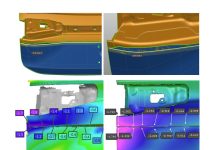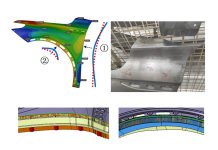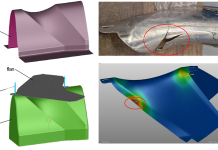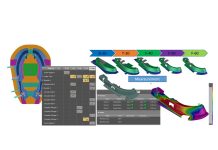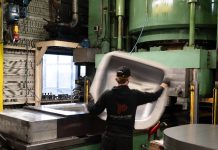In this article we examine how the successful evaluation of Robustness and Tryout Mapping by Nissan resulted in a push to see AutoForm-Sigmaplus routinely support new model tooling development.
Current high production volumes at Nissan, has put a high demand on their large press lines which are being utilized to maximum capacity. Thus the reliability of press production becomes increasingly important as there is simply no time to make corrective press adjustments during a press run to minimize waste. In turn, there is very limited press time available for trials of non-production parts/tools. Reductions in vehicle development lead times can be achieved by reducing the number of costly time consuming tryout loops and by accelerating the ramp-up to production volumes with SPC based process capability.
Nissan, as well as many other companies, adopt “Six Sigma”, which is a system that is designed to improve the quality of process outputs by identifying and removing the causes of defects and minimizing variability in manufacturing processes. To address such variability in sheet metal forming, AutoForm has developed AutoForm-Sigmaplus , an innovative simulation solution based on stochastics, to help press tool designers to systematically engineer robust stamping processes. Nissan NMUK Sunderland is the first press shop in the UK to adopt the AutoForm-Sigmaplus methodology and they have begun to see considerable success with this approach.
The key objective of the NMUK Press Shop is minimizing splits outflow. The objective limit is one part per million (trim shop) and in order to support this challenging target, the Die Maintenance department aims to improve the forming window/range in the draw process. Historically, draw die adjustment (blank holder force, blank position, and bead) during the Tryout and Production phases was very much based on experience (trial and error) and Nissan recognized that a Systematic Process Improvement (SPI) method was required.
Successful strategies
The initial application of AutoForm-Sigmaplus was on an unreliable part, typically a “bad runner”. Back door outer parts were splitting intermittently in production, and despite various engineering countermeasures being put in place, the problem was not eradicated. The robustness study indicated the biggest influence on panel quality to be “oil coating” level and significant improvement and stability were achieved by moving the die set to a new press line without a blank wash (Image 1).

Image 1: Robustness study – oil coating level cause of problem.
Sigma was also used to determine whether a material could be downgraded to achieve a cost reduction on a different component. Whilst the nominal simulation showed there would be no issues, a robustness analysis showed that further problems would result from the downgrade. As Nissan’s confidence level was high with respect to the ability of AutoForm to reflect reality, they were keen to utilize AutoForm-Sigmaplus to avoid problems in the press shop. Therefore, they developed a robustness standard and an engineering process for identifying and recording root cause analysis on formability and surface defect concerns for new model tooling arriving from Japan.
From theory to practice
“AutoForm has huge potential for us in the sheet metal forming environment. The AutoForm-Sigmaplus software allows us to simulate actual production conditions. Using Robustness (noise variables) we can provide early feedback to the Production department for high risk focus areas on the panel. The sigma SPI Tryout Map can be used in conjunction with robustness to confirm potential die modifications before actually modifying the tool. Working in the Press Shop, validation in the AutoForm software is clear as we see actual conditions on the panels that are highlighted by AutoForm simulation. Basically, it provides a more systematic approach, rather than “it’s a black art” mentality” says Graeme Haggon, Die Maintenance Supervisor, Nissan Sunderland Plant.
NMUK receive the draw dies (known as PB dies) for new models directly from Japan, for all in house produced parts. The robustness analysis begins with a representative process. A key point is that the base simulation draw–in/inflow should match the inflow on actual master PB panel. Typically, the simulation received from Japan shows a split free nominal simulation. However, a robustness analysis is conducted considering a range of inputs for variables such as material thickness, tensile/yield strength, yield point, r value, force and lube. This results in a range of outputs, including the possibilities of splitting (Image 2).

Image 2: A split free panel showing issues after robustness study.
Thus, whilst a single simulation provides a process point (supplied by Japan), it is clear that for successful Tryout as well as Production, a process range is required. A detailed study of the problem areas identified in the robustness study can indicate which variable has the highest influence in such areas and thus effective countermeasures can be determined (Image 3).

Image 3: Variables having highest influence in problem areas.
Robustness Cause and Effect Analysis
Robustness uses noise variables in the process that realistically cannot be controlled. SPI (Systematic Process Improvement) based on AutoForm-Sigmaplus is also used at Nissan to systematically evaluate the influence of design parameters on the robustness. SPI uses design variables that can be adjusted. In order to improve the draw process, SPI is used to create a Tryout Map which can then be used in conjunction with robustness.
A typical NMUK Tryout Map would include such variables as draw bead restraining force, blank position, pressure and lube. Influence plots can also be analyzed for SPI variables.
 Image 4: Influence plots showing result of Tryout Map
Image 4: Influence plots showing result of Tryout Map
It is paramount that the work done in the Sunderland Press Shop is fed back to Japan in order for the problems to be acted upon and eradicated as early as possible. Therefore, the feedback from the PB study is now fed back as a focus area to NMUK ‘buy-off’ team in Japan. In this way, countermeasures can be put in place, thus closing the loop.
Future of Robustness Prediction at NMUK
Robustness simulation allows the verification of the proposed current model die adjustment prior to actual change. Material grade change and blank reduction activities can be conducted. The approach can be used to support new model tooling developments. It provides the capability to feedback any formability issues to Japan and obtain early and effective countermeasures, based on clear understanding of variables influencing formability repeatability. A concerted effort will take place to encourage Nissan Japan to supply Nissan UK with Sigma Robustness results not just nominal. Internal development of Robustness and Tryout Map evaluation will continue thus increasing the reliability and benefits already reaped.
Nissan Sunderland Plant: The UK Press Shop
Established in Yokohama City, Kanagawa Prefecture in 1933, Nissan Motor Co., Ltd. currently manufactures vehicles in 20 countries and areas around the world, including Japan. Nissan offers products and services in more than 160 countries and areas worldwide. For detailed information please visit: www.nissan-europe.com
AutoForm Engineering GmbH
AutoForm offers software solutions for the die-making and sheet metal forming industries along the entire process chain. With 300 employees dedicated to this field, AutoForm is recognized as the leading provider of software for product manufacturability, tool and material cost calculation, die face design and virtual process optimization. All of the Top 20 automotive OEMs and most of their suppliers have selected AutoForm as their software of choice. Besides its headquarters in Switzerland, AutoForm has offices in Germany, The Netherlands, France, Spain, Italy, USA, Mexico, Brazil, India, China, Japan and Korea. AutoForm is also present through its agents in more than 15 other countries. For detailed information please visit: www.autoform.com




